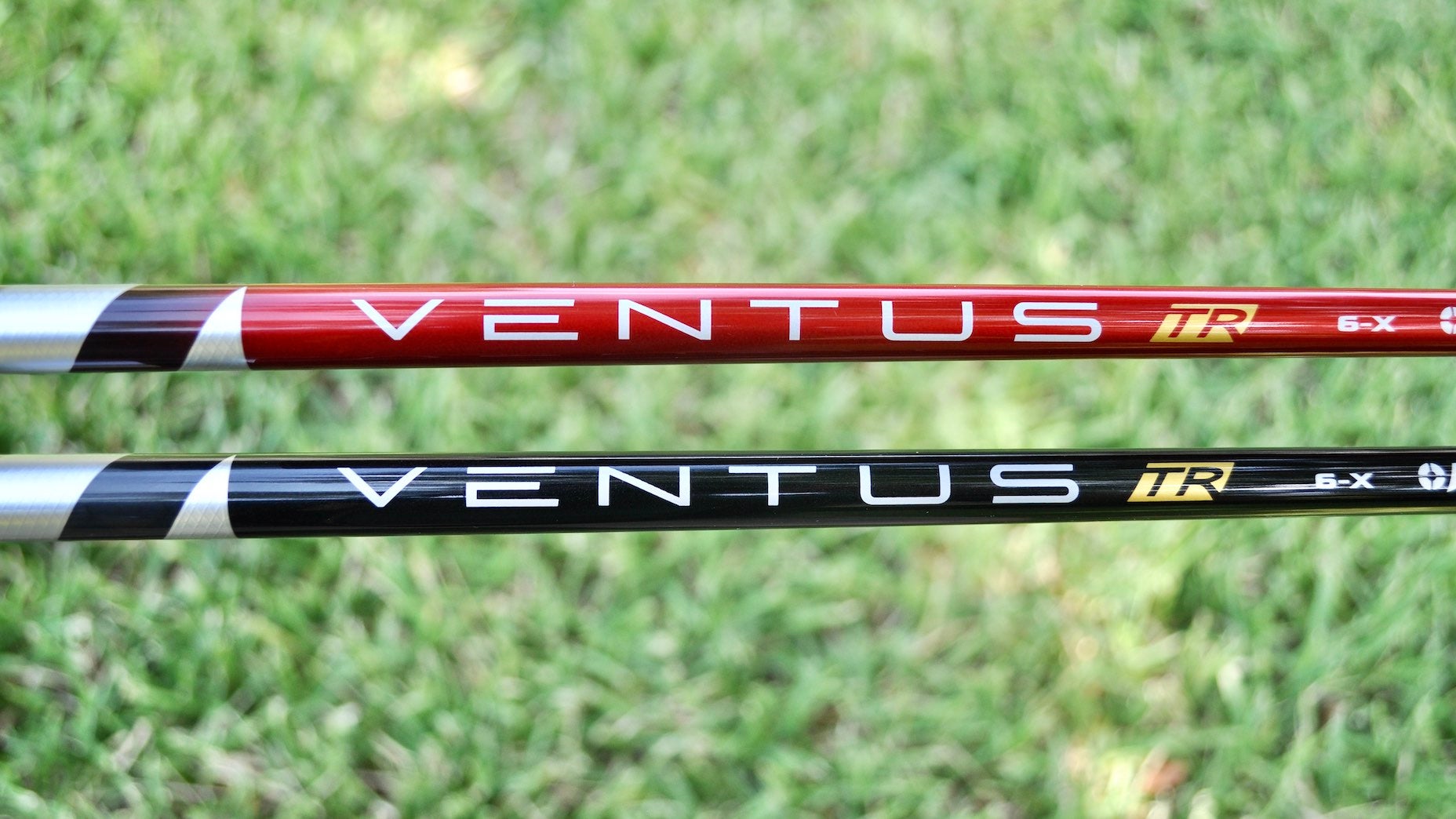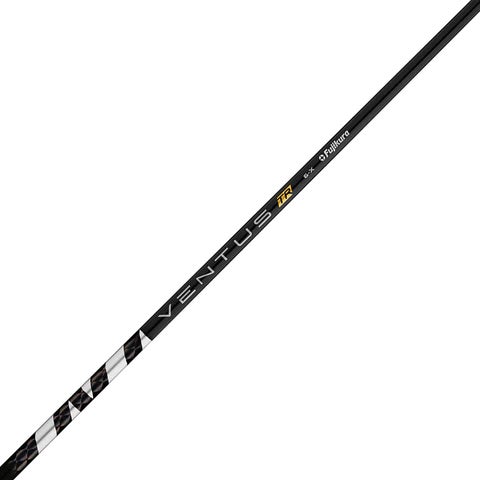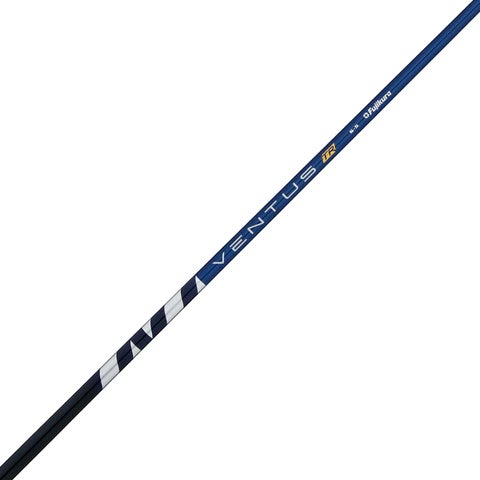
Ventus TR Red and Black offer two wildly different profiles.
Jonathan Wall/GOLF
Many golfers wrongfully assume that aftermarket shafts are only for serious and/or better golfers who seemingly know or care more about their equipment. Of course, that’s not true — aftermarket shafts (that’s what we call shafts you buy separately or as custom options when you buy a new club) can be advantageous for anyone.
Really, everyone should be getting custom-fit for a shaft these days.
We asked the folks over at Fujikura in Carlsbad, Calif., about why they think many of the golfing public don’t bother to explore the aftermarket shaft fitting route. According to the company’s director of marketing, Eric Recher, “probably the biggest reason why people don’t get fit is the general lack of education about golf shaft specs. Gearheads are familiar with things like torque, EI profiles (elasticity), CPM variances (flex), but average players aren’t.”
In other words, what many golfers don’t know might be negatively affecting how well their clubs could perform.
Recher continued, “golfers don’t fully realize how different an S flex can be from shaft to shaft both within a manufacturer and between manufacturers. A Ventus Black 6S plays, feels, and performs significantly differently than our Vista Pro 6S due to material differences, and so on. Frankly, all S flexes are definitely not created equal.” So, if you’re among the golfers who think choosing a shaft by flex designation alone is good enough, it’s possible you’re sorely mistaken.
Another reason many golfers haven’t sought a shaft fitting session is that they think what worked then will still work now. “We’ve seen players thinking they are best suited to use a 9.5-degree driver because that’s what they’ve used for decades,” said Recher. “They don’t realize how much has changed in terms of the launch and spin modern-day heads produce. The shaft plays a huge role in how well a clubhead can deliver the goods, and it’s possible the shaft profile you once loved just isn’t the right fit anymore.”
So where do we go from here? Simple. It’s time to get educated on the basics so you know what to do, what to expect and how to navigate through the shaft buying process.
Step 1: Go see a shaft fitter
This is the easiest step and for the matter, pretty much all you need to do. Take Fujikura for example. You can get fit for a Fujikura shaft via numerous shaft dealer locations around the country, all of whom are certified to fit you with precisely the right Fujikura shaft for your game. Remember, look for shaft fitters that are certified—they’re the ones who know what to look for and are trained to help you dial in the perfect shaft based on your needs, wants and abilities.
All of our market picks are independently selected and curated by the editorial team. If you buy a linked product, GOLF.COM may earn a fee. Pricing may vary.
Fujikura Ventus TR Black
$350.00
New for 2022! Introducing a new profile to the lineup, Ventus TR. Born from the continuous quest for improvement and backed by enso®–driven analytics and Tour feedback, Ventus TR builds upon one of the most trusted and best-selling wood shafts in Fujikura history. Jockey Tip: The TR Black is the stiffest VENTUS profile to date. Ultra-stiff tip and handle sections work in unison to support players with Tour-like speeds that prefer the feeling of minimal to no flex during the swing. As a shaft designed for players with a fast transition, spread tow fabric reinforces the mid/handle section even further, holding up to even the most aggressive moves to the golf ball.
Step 2: Tell the truth, especially when the ball doesn’t
This may seem silly, but honesty in your fitting is essential. You may be having a great day and are hitting the screws during your fitting, but if that’s not your normal, you have to let the fitter know. An experienced shaft fitter knows that a proper fitting isn’t measured simply by how well you hit your good ones, but also how playable your miss-hits and/or bad swings are.
According to Recher, “Miss-hits (on the clubface) and inconsistent misses (both hooks and slices) are tell-tale signs that someone could benefit from a shaft fitting.” This means, that unless a fitter sees the real you, it won’t be as easy to discern what you need.
Step 3: Be open to change and check your ego at the door
As mentioned already, shaft flex is a designation that not only varies from brand to brand, it’s different from model to model. You might have always used an X or S flex for the better part of your golfing days but based on your swing characteristics and desired shot shape, you might be better suited for an R flex shaft. The same goes for model or even shaft type, be it heavier, lighter, or even one with a different bend profile than you think you need. Keep an open mind and you’ll be better off.
Fujikura Ventus TR Red
$350.00
New for 2022! Introducing a new profile to the lineup, Ventus TR. Born from the continuous quest for improvement and backed by enso®–driven analytics and Tour feedback, Ventus TR builds upon one of the most trusted and best-selling wood shafts in Fujikura history. Jockey Tip: The TR Black is the stiffest VENTUS profile to date. Ultra-stiff tip and handle sections work in unison to support players with Tour-like speeds that prefer the feeling of minimal to no flex during the swing. As a shaft designed for players with a fast transition, spread tow fabric reinforces the mid/handle section even further, holding up to even the most aggressive moves to the golf ball.
Step 4: Expect a possible swing change (in a good way)
Knowing when you have the wrong shaft is sometimes easy. It either feels too light, too heavy, too long, too short, too stiff or you guessed it, too flexible. A shaft that isn’t fit for you can affect how you swing the club, often messing up your timing and ability to make solid contact. “Our job as shaft experts is to fit your swing with the club and deliver the clubhead back to the ball in the most efficient way to maximize the shot performance,” said Recher. “A properly fitted shaft will lead to a better swing for any golfer, be it a professional or weekend amateur.”
Fujikura Ventus TR Blue
$350.00
New for 2022! Introducing a new profile to the lineup, Ventus TR. Born from the continuous quest for improvement and backed by enso®–driven analytics and Tour feedback, Ventus TR builds upon one of the most trusted and best-selling wood shafts in Fujikura history. Jockey Tip: The TR Black is the stiffest VENTUS profile to date. Ultra-stiff tip and handle sections work in unison to support players with Tour-like speeds that prefer the feeling of minimal to no flex during the swing. As a shaft designed for players with a fast transition, spread tow fabric reinforces the mid/handle section even further, holding up to even the most aggressive moves to the golf ball.
Step 5: See your swing doctor after you get fit
In case you were wondering about the chicken vs the egg thing as it relates to whether you should get your clubs fit or see a swing teacher, the answer is clear—get fit first. If you have the wrong shaft in play and you’re manipulating your swing to “make it work”, you’re doing yourself a disservice. Get fit first and you’ll reap greater rewards come time to fine tune your swing.
See? Getting fit for a new shaft isn’t all that complicated. In about an hour or less, you’ll know exactly what shaft is best for you. To take that first step, the Fujikura Dealer Locator is a great place to start.











